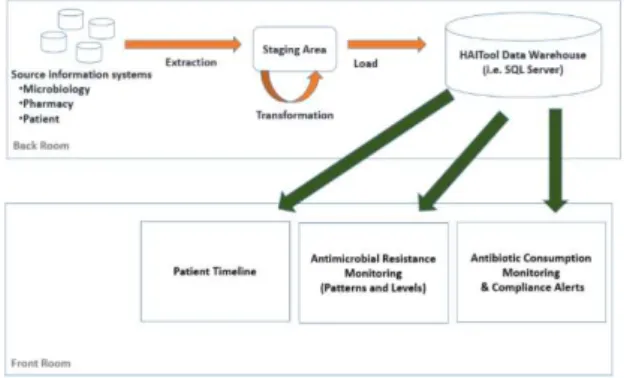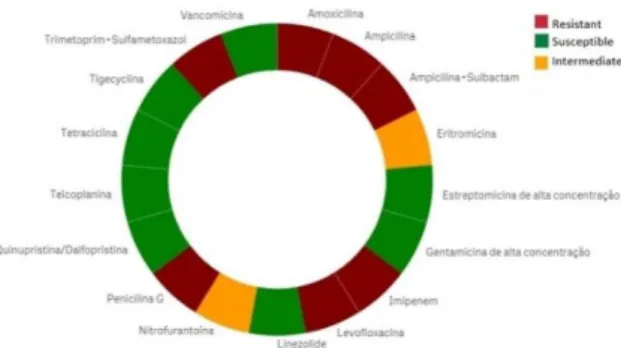Co-Design of a Computer-Assisted
Medical Decision Support System to
Manage Antibiotic Prescription in an ICU
Ward
Miguel GIL a, Pedro PINTOa, Alexandra S. SIMÕESa, Pedro PÓVOA b, Miguel Mira DA SILVA c and Luís Velez LAPÃOa, 1
aGlobal Health and Tropical Medicine, Instituto de Higiene e Medicina Tropical,
Universidade Nova de Lisboa, Portugal
bUCIP, Hospital São Francisco Xavier, Centro Hospitalar Lisboa Ocidental, Portugal cInstituto Superior Técnico, Universidade de Lisboa, Portugal
Abstract. About 37 thousand people die per year in Europe due to infections by
resistant bacteria. Fighting antimicrobial resistances (AR) is a top priority to save lives and reduce costs. AR is triggered mostly by uncritical antibiotic prescription. This paper presents HAITool, a decision-making information system to support antibiotic prescription. The system was co-developed together with health professionals using Design Science Research Methodology, empowered with innovative data visualization techniques to improve AR management. HAITool includes integrated visualizations of patient, microbiology, and pharmacy data, facilitating clinical decision support, antibiotic prescriptions quality and antibiotic-resistant bacteria monitoring. It also includes an alert module that monitors conformance of antibiotic prescriptions with norms and guidelines. HAITool is evaluated using both the Österle principles and interviews with physicians and infection control team from three participant hospitals.
Keywords. Computer-Assisted Medical Decision Support System, design science research methodology, co-design, Antibiotic prescription, Antibiotic Stewardship
1.Introduction
Healthcare-associated infections (HAI) are one of the major worldwide causes of death and disability, with an important economic impact of several billion dollars/year in the USA [1]. Antimicrobial resistance (AR) increase even more morbidity, mortality and costs associated with HAI [2]. Antibiotic (AB) misuse is at the heart of AR: uncritical AB prescription leads to the development of antimicrobial resistant bacteria [3]. Antimicrobial resistant HAI can be addressed by interventions reducing unnecessary AB prescribing [4]. However, infection control team spend most of their time on data collection, suspected cases finding, medical records review, etc., and it is hard for them to have time for dealing with proactive preventive activities [5]. This problem can be tackled with computerized surveillance and decision support systems, which have proven
to be effective in the prescription errors reduction, medical care improvement and compliance with recommendations [6]. These systems will not replace clinical judgement. Their purpose is to increase the information available, so healthcare professionals can improve the decision process [7]. HAI surveillance, clinical decision support, overviews of complex matters, alerts, and reminders have an added value [8]. Antibiotic Stewardship Programs (ABS) have been developed to decrease prevalence of AR. ABS could contribute to the optimization of antibiotic prescription, promoting the adequate use (e.g. dose and duration) and reducing costs [3]. Clinical decision support systems (CDSS) are playing an increasingly important role in providing recommendations. The integration of CDSS into electronic health records has been shown to improve the quality of care and to enhance patient out-comes [9]. Interactive and integrated data visualization could increase the under-standing of a patient’s infection status and enhance AB decision-making [10].
2.Methods
This paper presents HAITool, a surveillance and clinical decision support system expected to contribute to reduce antibiotic misuse and resistance. The project was conducted using Design Science Research Methodology (DSRM) which establishes a six-stage process, namely problem identification, objectives definition, design and development, demonstration, evaluation, and communication [11]. In this research case we propose an instantiation (i.e. software).
Figure 1. HAITool's architecture.
3.Proposal
In this section the HAITool research and co-design objectives are presented.
3.1.Objectives
The objectives of this research are the following:
Monitoring AB consumption - updated data on AB consumptions is relevant
for monitoring antimicrobial resistance.
Monitoring AB resistant bacteria - updated data on AB resistant bacteria rates
Promote AB prescription based on guidelines - to have an integrated view of patient-data and alerts-based on guidelines eases AB prescriptions.
3.2.Design
HAITool is a web-based information system supported by a SQL Server (2012) database which combines and stores pharmacy, microbiology, and patient-related information (Fig. 1). The current Extract-Transformation-Load (ETL) module is written in Java. Regarding data visualization, Qlik Sense is used (with some extensions). Qlik Sense is the newest release from Qlik, which is also the company owning QlikView, that have already been used within several healthcare research contexts [12].
4.Demonstration
HAITool’s demonstration took place in an Intensive Care Unit (8 beds), in a tertiary Portuguese hospital. The research objectives were successfully achieved: HAITool correctly portrayed data allowing infection control team to discover AB consumption levels, rates of AB resistant bacteria and conformance of AB prescriptions.
One of the main features of the solution is the visualization of AB resistance patterns through simple and clear graphs (Figure 2). The information can be further filtered by microorganism and ward, which facilitates the visualization. For instance, color green shows AB for which no cases of resistance were found in a specific organism, informing physicians about which AB is more likely to treat the suspected microorganism in the specified ward. In situations where AR is found, the AB is portrayed by a red color in the diagram indicating that the AB will not treat the patient. Intermediate resistance is represented by the orange color. In cases where the microorganism is resistant to an AB in a patient but susceptible in another one, the AB appears blue. This visualization also allows to filter by patient, which means that it is possible for the physicians and infection control team to see the antibiogram results for each and every patient that is (or was) hospitalized.
Figure 2. HAITool's microorganism resistance patterns visualization through a donut chart.
5.Evaluation
HAITool evaluation was based on interviews with physicians and infection control team, as well as by using Österle principles. Interviews evaluated the first cycle of design and implementation of HAITool. Structured interviews [15] were supported by a pre-elaborated survey. The overall survey answers indicated that HAITool is “very useful” on preventing and control AR by providing AB resistant patterns, AB consumption rates, enhance the communication between infection control team, microbiology laboratory, physicians and pharmacists, as well as the relevance of alerts on AB prescriptions compliance with norms. Design-oriented information system research must follow four basic principles: abstraction, originality, justification and benefit, also known as principles of Österle [16]:
Abstraction: HAITool may be used by physicians and infection control team
to tackle AB misuse at both public and private hospitals. Its data requirements are commonly available in any hospital.
Originality: HAITool was designed by a multidisciplinary team including
healthcare professionals, contributing to the creation of a system oriented to their real needs. HAITool is supported by Qlik Sense, the newest product provided by Qlik.com.
Justification: According to WHO, HAI are a major worldwide cause of death
[1]. HAITool is an information system to help prevent, manage and control HAI that was validated by physicians and infection control team.
Benefit: It benefits health organizations and the society at large by providing an
integrated view on patient and facilitating the work of physicians and infection control team. It also contributes to more informed empirical AB prescriptions, once it allows physicians to check AB resistance, speeding up the decision process.
6.Conclusion
than 30 healthcare professionals, including the hospital administrator, physicians, nurses, researchers, and infection control team. Besides, HAITool internet portal and periodical reports to hospitals are also enforcing the communication of the research results. We believe that HAITool achieved the research objectives, according to the current feedback from healthcare professionals. The next step is measuring the impact of AB consumption and prescription compliance with the norms, alerts effectiveness, bacteria resistances and costs. We are also studying the adherence of physicians and infection control practitioners to HAITool.
Acknowledgements
This work was supported by project "HAITool - A Toolkit to Prevent, Manage and Control Healthcare-Associated Infections in Portugal" (Ref: 000182DT3), funded by Norway, Iceland and Liechtenstein, under EEA Grants Program, and by FCT for funds to GHTM – UID/Multi/04413/2013.
References
[1] Scott, R. D. “The direct medical costs of healthcare-associated infections in US hospitals and the benefits of prevention.” Division of Healthcare Quality Promotion National Center for Preparedness, Detection, and Control of Infectious Diseases, Centers for Disease Control and Prevention, (2009).
[2] Neidell, M. J., et al. “Costs of healthcare-and community-associated infections with antimicrobial-resistant versus susceptible organisms.” Clinical Infectious Diseases (2012): cis552.
[3] Bell, B. G., et al. "A systematic review and meta-analysis of the effects of antibiotic consumption on antibiotic resistance." BMC Infectious Diseases 14.1 (2014): 1.
[4] Davey, P., et al. “Interventions to improve antibiotic prescribing practices for hospital inpatients.” The Cochrane Library (2013).
[5] Atreja, A., et al. “Opportunities and challenges in utilizing electronic health records for infection surveillance, prevention, and control.” American Journal of Infection Control 36.3 (2008): S37-S46. [6] Pestotnik, S. L. “Expert clinical decision support systems to enhance antimicrobial stewardship programs
insights society of infectious diseases pharmacists.” Pharmacotherapy: The Journal of Human Pharmacology and Drug Therapy 25.8 (2005): 1116-1125.
[7] Rodríguez-Baño, J., et al. “Programs for optimizing the use of antibiotics (PROA) in Spanish hospitals: GEIH-SEIMC, SEFH and SEMPSPH consensus document.” Farmacia Hospitalaria: Organo Oficial de Expresion Cientifica de la Sociedad Espanola de Farmacia Hospitalaria 36.1 (2011): 33-e1.
[8] Adlassnig, K.P., et al. “Healthcare-associated infection surveillance and bedside alerts.” Studies in Health Technology and Informatics 198 (2014): 71-78.
[9] McGregor, J. C., et al. “Impact of a computerized clinical decision support system on reducing inappropriate antimicrobial use: a randomized controlled trial.” Journal of the American Medical Informatics Association 13.4 (2006): 378-384.
[10] Forsman, J., et al. “Integrated information visualization to support decision making for use of antibiotics in intensive care: design and usability evaluation.” Informatics for Health and Social Care 38.4 (2013): 330-353.
[11] Peffers, Ken, et al. “A design science research methodology for information systems research.” Journal of management information systems 24.3 (2007): 45-77.
[12] Zeng, J., and John Zhang. “Visual data discovery to support patient care.” International Conference on Smart Health. Springer Berlin Heidelberg, (2013).
[13] Rojo, D., et al. “Analysis of risk factors associated with nosocomial bacteraemias.” Journal of Hospital Infection 42.2 (1999): 135-141.
[14] Direção-Geral da Saúde. Duração de Terapêutica Antibiótica. (2014).
[15] Oates, B. J. “Researching information systems and computing.” Sage Publications, (2006).

